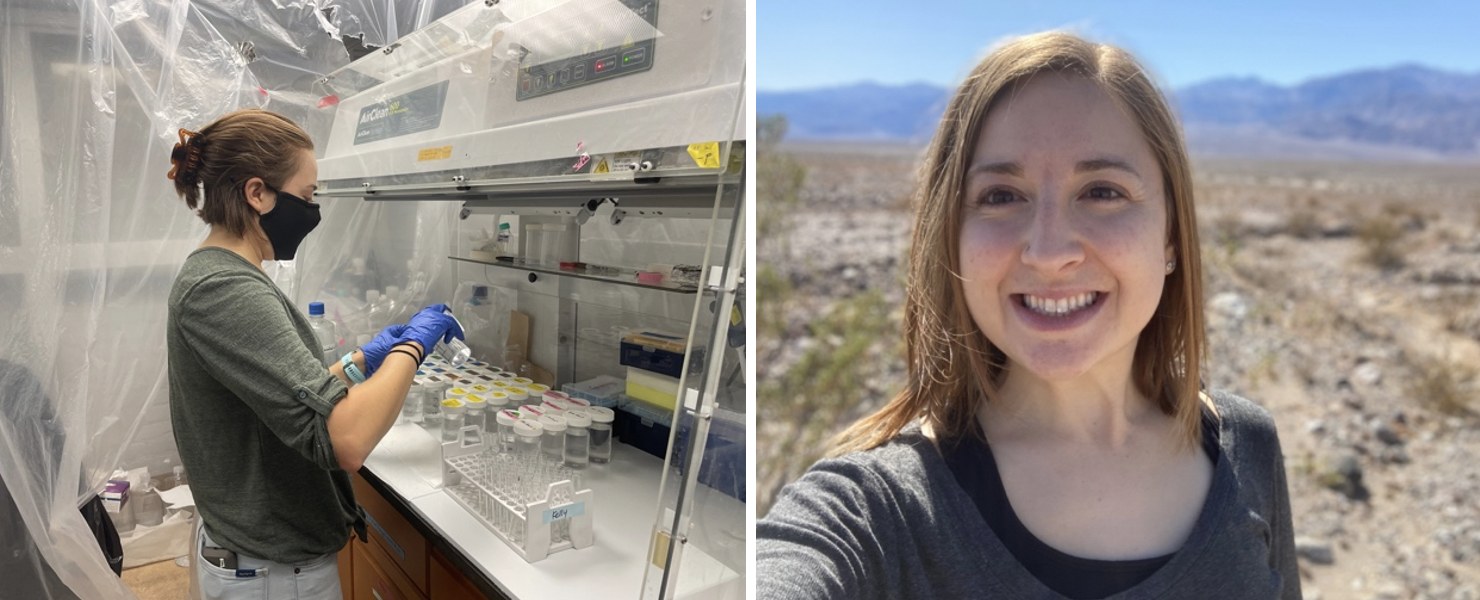By: Kyla Kelly
Hi everyone! My name is Kyla Kelly, and I am a 4th year Ph.D. candidate in the University of Southern California’s Marine Biology and Biological Oceanography program. As a member of Dr. David Hutchins’ lab, I study marine harmful algal blooms in the face of climate change. These toxic phytoplankton (commonly known as “red” or “brown tides”) bloom annually off the west coast of the United States, threatening human health, marine ecosystems, and local economies. Learning more about them though research could provide HAB monitoring and coastal management agencies with a greater understanding of what may be causing these toxic blooms to occur, and how they may be exacerbated by climate change.

Me taking care of my phytoplankton in the lab (left) and me enjoying the great outdoors (when not in the lab; right).
As a recipient of the Wrigley Institute’s Norma and Jerol Sonosky Summer Sustainability Fellowship , I spent my summer studying how a red tide-causing species (Alexandrium sp.) may be affected by two climate change variables: warming and nutrient limitation. Climate change is causing surface ocean temperatures to rise, so the phytoplankton living there must endure these warmer, potentially stressful conditions. This may change the way that Alexandrium sp. grows and produces saxitoxin – a neurotoxin that, when ingested, can be harmful to human health.
Nutrient limitation may also alter the way that Alexandrium sp. “behaves”. Warming can cause the ocean to become more stratified (i.e., the nutrient-rich bottom waters have trouble mixing with the nutrient-depleted surface waters). Nutrients such as phosphate and nitrate are essential to phytoplankton growth, yet this stratification could reduce the availability or supply of these nutrients. Furthermore, warming can interact with nutrient limitation by changing how efficiently phytoplankton can absorb these nutrients. This could have implications for toxic bloom formation by Alexandrium sp..

Alexandrium sp. cells under the microscope. Note the scale bar – these guys are pretty tiny! Image from https://green2.kingcounty.gov/marine/Photo/Individual/2/406?photoId=1048
We are performing an experiment to figure out how Alexandrium sp. may be impacted by the simultaneous warming and nutrient limitation we expect in a future ocean altered by climate change. We are using a thermal block to create a gradient of temperatures ranging from 12 to 26°C – with 12°C representing wintertime ocean temperatures, 22°C reflecting temperatures we see in the summer, and 26°C representing a future, warmer ocean. Each column in the thermal block is a different temperature, with cooler treatments on the left, and warmer treatments to the right. Within each column, we are growing Alexandrium sp. in 9 culturing flasks: three have all the nutrients they need to grow normally (this makes them happy), three have less phosphate available and are considered “phosphate limited”, and three have reduced concentrations of nitrate, and are therefore “nitrate limited”.

Our experimental setup in the thermal block. The coldest temperature treatments are all the way to the left in column one. Each successive column increases approximately 1-1.5°C, moving to the right.
This experiment is still in progress. The phytoplankton are currently acclimating (or getting used to) to experimental conditions. Once acclimation has been achieved, we expect to see differences in growth rates and toxin production for each temperature and nutrient treatment. We predict that warmer, phosphate limited treatments will grow slower, but produce more toxins (compared to colder, nitrate limited treatments).
These data will help us learn how nitrate and phosphate play different roles in growth and toxin production, and how temperature may impact the way in which Alexandrium sp. uses these nutrients. I am excited to continue working on this research project, and thankful for being awarded the Sonosky Fellowship in support of my work!




